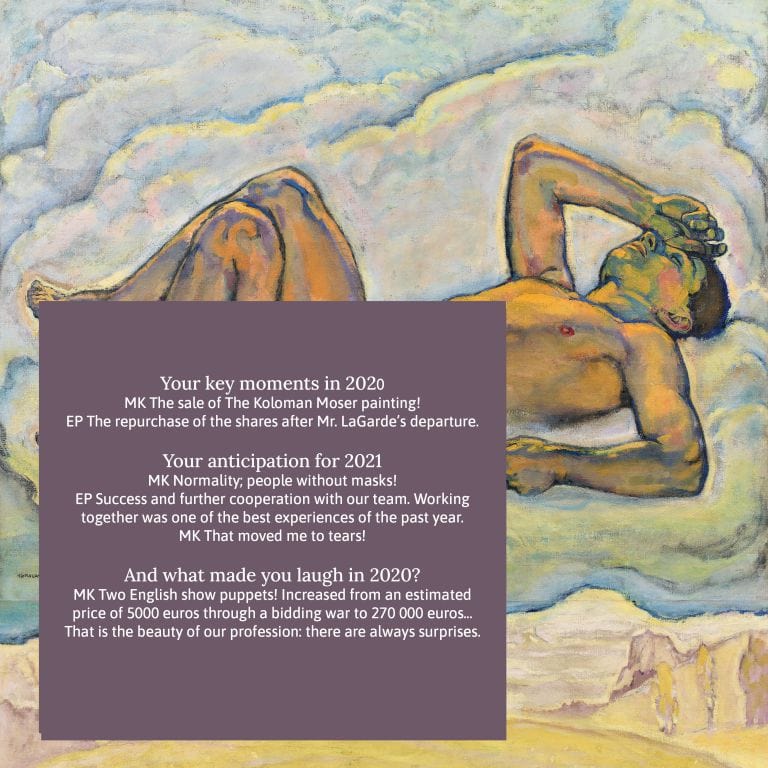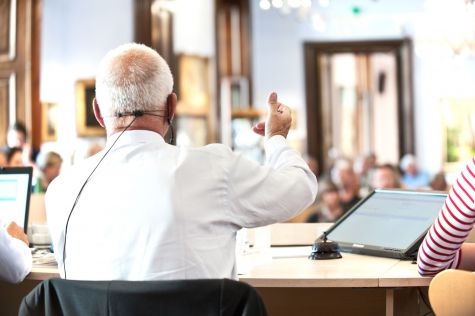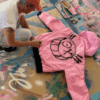In this interview, the owners of im Kinsky – Michael Kovacek & Dr. Ernst Ploil – look back on a challenging year and offer exciting insights into the future of the art market.
How did you feel in March 2020?
Ernst Poil: We were expecting the worst…
Michael Kovacek: … and of course overall sales are reduced…
Ernst Poil: But we managed to turn things around, and successfully so. Therefore, we have a business result that is not only above expectations, but also within our hopes.
Michael Kovacek: After every restriction due to Covid-19, I have looked for coping strategies, and they have ultimately led to great success.
Ernst Poil: Michael Kovacek is an optimist, thank God, who was proved right in the end. However, the pandemic and the concurrent legal restrictions have been a huge burden and have led to rethinking the entire business model.
Michael Kovacek: We had to postpone two auctions…
Ernst Poil:… and cancel the Time Travel exhibition! But we adjusted to the situation as quickly as we could. For example, we offer delivery services so that people do not have to come here in person, we have simplified and strengthened our online bidding tools, all of this has proven successful.
At the last auction we had a record with 950 registered online bidders!
Michael Kovacek
How will the auction system develop?
MK: It will continue to grow strongly.
EP: The art market will also grow, as it is an investment opportunity. There is a national economic principle which is: in the event of a crisis, people invest into tangible assets. We are certainly experiencing colossal structural changes this year and next year with many bankruptcies and company collapses…
MK: … and with certainly many start-ups, restructurings, and new success stories!
EP: Interest rates are low, other investment models are less attractive – so people will continue to invest in art.
MK: We agree on this!
EP: And the pandemic will pass like the flu epidemic did. Stock markets are already booming because they anticipate the effects of vaccination and economic recovery. This is going to make an impression on the art market, too.

Are more objects of value coming onto the market now?
MK: No. Acquisition has actually become more difficult because people believe they won’t achieve high prices because of the crisis. But they could not be more wrong.
EP: The group of people who now yields values is the first post-war generation – and they are getting old in great prosperity. For them there is no hurry to separate themselves from items they love, and certainly not from the excellent things.
MK: To this I would like to add: In most cases, buying art is not an investment purchase but it is more about a feeling of happiness! And you do not part with things you love – that’s what the heirs will later do.
As a lawyer I hear the question again and again: How do I leave my assets in a smart way? And I say regularly: if you have a special knowledge, then use it and sell your items yourself.
Ernst Poil
Do people heed your advice?
EP (laughs): Everyone nods, but nobody sells. Because you cannot separate from the things you love. Only very few people manage this.

Is this a generational issue? Is the younger generation different?
MK: Absolutely. The older generation has amassed a collection and is not separating from it. Today’s contemporary collector buys young art, observes the market, and separates after 5, 10 or 15 years with much less attachment to the pieces. That is why the Contemporary Art department works so well!
EP: The view of art is a generational question. Regarding Contemporary Art, I see a quite different approach than in my youth. If someone bought a Rainer then – and it was already expensive at that time! – it was a daring act of madness. Today, the purchase of art is often seen as a possible form of investment.
MK: But not everybody thinks that way. However, some people believe that they can make good money by flipping art and have something nice hanging at home at the same time. Art has become very commercialized.
EP: I agree. In this day and age – it may be due to education, or to the easier handling of money and wealth – everyone wants to make a good investment. People want to hang a work on their wall, but also want to be able to say: I bought it well.
And when someone buys expensive art from us, they need not be self-conscious about it, because it shows that they have made a smart investment.
Michael Kovacek
EP: This has always been our strategy: the im Kinsky as a hub for economic and scientific questions. We look behind the merely commercial facade, we research the history, we know how the specific object can be placed in the context of the artist’s overall work.

Interview: im Kinsky








